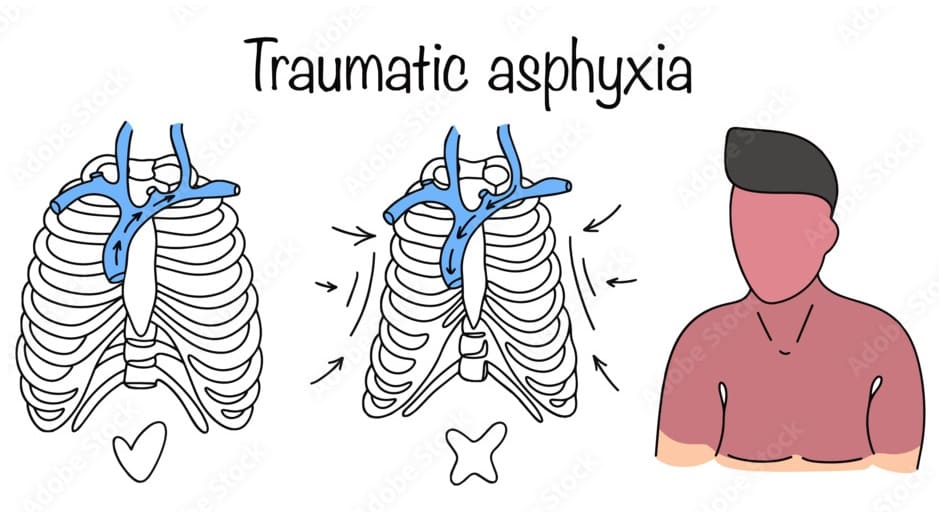Stampedes can turn joyous events into devastating tragedies within moments. Whether at a crowded concert, a pilgrimage site, or a packed stadium, the chaos of a stampede can lead to multiple fatalities. One of the primary causes of death in such incidents is traumatic asphyxia—a term often mentioned in reports but not always fully understood. Let’s break it down with insights from experts.
What is Traumatic Asphyxia?
Traumatic asphyxia, also known as crush asphyxia, occurs when intense external pressure is exerted on the chest, preventing normal breathing. This condition leads to a sudden lack of oxygen, which can cause unconsciousness and, if prolonged, death. The hallmark of traumatic asphyxia is the rapid compression of the thoracic cavity, often due to being crushed in a crowd or under heavy objects.
How Does It Occur in a Stampede?
During a stampede, the sheer force of a densely packed crowd can create overwhelming pressure on individuals caught in the middle. Victims may be pushed against barriers, trampled, or pinned beneath others, leading to severe chest compression. According to Dr. Richard L. Lichen, a trauma specialist, “When people in a crowd fall or are compressed against walls, their lungs cannot expand to draw in air, leading to oxygen deprivation within minutes.”
The Physiological Impact
Experts explain that traumatic asphyxia has distinct physiological effects:
- Impaired breathing: The diaphragm and chest muscles cannot function normally, cutting off oxygen supply.
- Cyanosis (bluish discoloration): Blood flow is disrupted, causing the face, neck, and upper chest to turn a deep red or blue due to increased venous pressure.
- Petechial hemorrhages: Small red spots may appear in the eyes and skin due to ruptured capillaries.
- Rapid unconsciousness: Without immediate intervention, the brain and vital organs suffer from a lack of oxygen, leading to fatal outcomes within minutes.
- Cardiac Arrest: Prolonged oxygen deprivation can lead to heart failure and irreversible damage to the cardiovascular system.
Real-Life Examples of Traumatic Asphyxia in Stampedes
Several major stampedes in history have resulted in traumatic asphyxia-related deaths:
- The Hajj Stampede (2015): One of the deadliest stampedes in history, occurring during the annual Islamic pilgrimage in Mecca, led to over 2,400 fatalities, with traumatic asphyxia being a significant cause of death.
- The Hillsborough Disaster (1989): A crush at an overcrowded soccer stadium in Sheffield, England, caused 97 deaths, with victims suffering severe traumatic asphyxia.
- Astroworld Festival Tragedy (2021): A crowd surge at the music festival in Houston, Texas, led to multiple deaths and injuries, with traumatic asphyxia cited as a primary cause.
Can Traumatic Asphyxia Be Prevented?
While stampedes are unpredictable, experts recommend several measures to reduce the risk:
- Crowd management strategies: Authorities must implement better crowd control, including designated entry and exit points and controlled ticketing.
- Public awareness: Event attendees should be educated on staying calm, identifying exits, and avoiding pushing or rushing.
- Emergency response training: First responders must be trained to quickly identify and assist victims of traumatic asphyxia.
- Structural Modifications: Venues should ensure adequate space, clear pathways, and emergency escape routes to minimize overcrowding risks.
- Advanced Warning Systems: The use of real-time crowd monitoring technology can help predict and prevent dangerous crowd surges before they become deadly.
Final Thoughts
Understanding traumatic asphyxia is crucial in highlighting the deadly risks of uncontrolled crowds. Experts emphasize the importance of preventive measures, emergency preparedness, and public education to minimize tragedies in high-density events. By acknowledging these risks and implementing safety protocols, we can work toward preventing future stampede-related fatalities.
Also Read:
